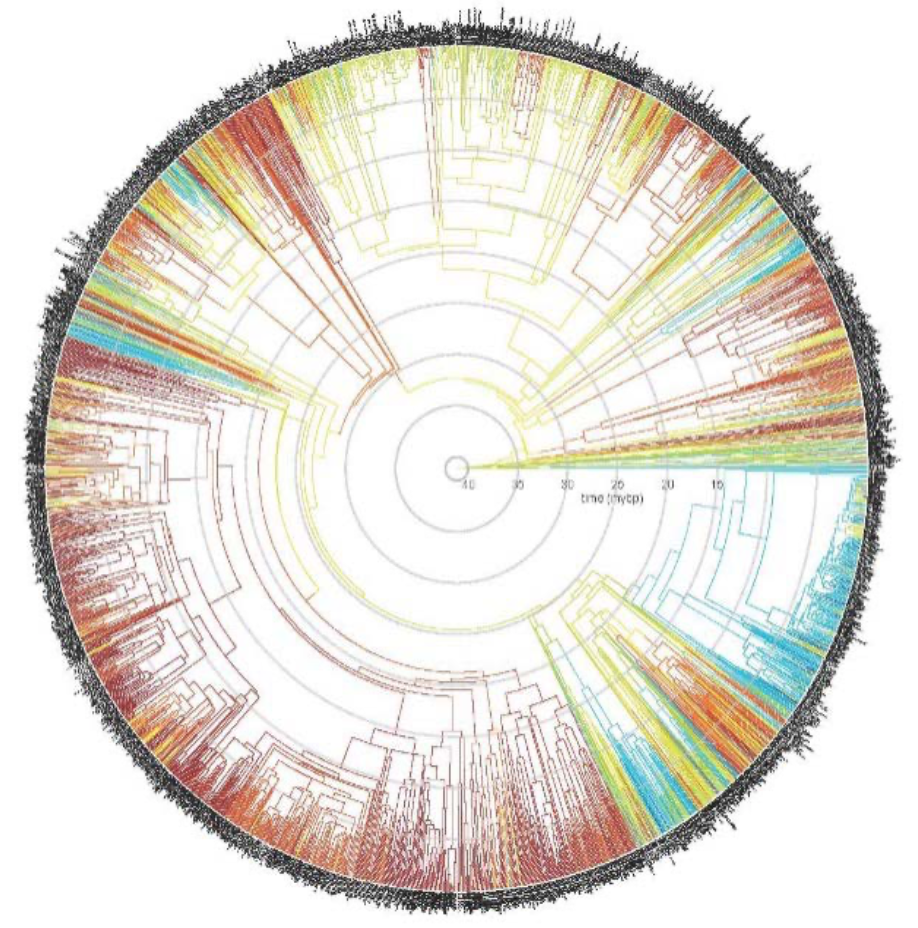PHYLOGENOMICS WORKING GROUP
Coordinator:
Félix Forest (Royal Botanic Gardens, Kew, UK)
Phylogenomics of legumes
The Plant and Fungal Trees of Life (PAFTOL) project at Royal Botanic Gardens, Kew (https://www.kew.org/science/our-science/projects/plant-and-fungal-trees-of-life) has been making good progress in recent months towards a complete genus-level phylogeny of legumes based on target enrichment sequencing using the universal probe set Angiosperms353. The team, thanks in large part to invaluable help from Gwilym Lewis, has now secured material (DNA, tissue) or sequence data for all genera of legumes currently recognized with just a few exceptions (see below). Lead on the project is Rafaela Trad, postdoctoral fellow at Royal Botanic Gardens Edinburgh, funded by the Botanics Foundation. Working in collaboration with Rafaela and the PAFTOL team are Greg Kenicer, Flávia Pezzini, Toby Pennington, Gwilym Lewis and Bente Klitgaard with support from Janet Sprent. The group will lead on the phylogenomic analyses for the family once the recently acquired material has been sequenced. It is important to note that for these genus-level analyses in PAFTOL, in most cases, only one species per genus has been sampled.
The genera for which material is still sought are Delgadoa, Kanburia, Mantiquera, Neocolletia, Pictarena, Sartoria, and Vuralia. We have a few possibilities in mind of source material for these, but if you have access to tissue or DNA for species of these genera, please get in touch with Félix Forest.
Phylogenomics of Caesalpinioideae
A new backbone phylogeny for subfamily Caesalpinioideae, constructed using the 997 nuclear genes of the Mimobaits gene set of Koenen et al. (2020), and sampling 420 species from 147 of the then 152 genera, was published during 2022 (Ringelberg et al. 2022a). The extensive non-monophyly of genera revealed in this phylogeny was documented in detail by Ringelberg et al. (2022a), forming the basis for subsequent re-delimitation of 15 genera across the subfamily which is the focus of Advances in Legume Systematics 14 (Part 1), also published in 2022. This new backbone phylogeny has been deployed to investigate the evolutionary stability of nodulation across subfamily Caesalpinioideae (Faria et al. 2022) and the biogeography of mimosoids (Ringelberg et al. 2022b) and provides the basis for the upcoming new higher-level tribal and clade-based classification of the subfamily in preparation for publication in ALS14 Part 2.

Faria, S.M., Ringelberg, J., Gross, E., Koenen, E.J.M., Cardoso, D., Ametsitsi, J.K.D., Akomatey, J., Maluk, M., Tak, N., Gehlot, H.S., Wright, K.M., Teaumroong, N., Songwattana, P., de Lima, H.C., Prin, Y., Zartmann, C., Sprent, J.I., Ardley, J., Hughes, C.E. & James, E.K. (2022). The innovation of the symbiosome has enhanced the evolutionary stability of nitrogen fixation in legumes. New Phytologist 235: 2365-2377. https://doi.org/10.1111/nph.18321
Koenen, E.J.M., Kidner, C., de Souza, E.R., Simon, M.F., Iganci, J.R., Nicholls, J.A., Brown, G.K., de Queiroz, L.P., Luckow, M., Lewis, G.P., Pennington, R.T. & Hughes, C.E. (2020). Hybrid capture of 964 nuclear genes resolves evolutionary relationships in the mimosoid legumes and reveals the polytomous origins of a large pantropical radiation. American Journal of Botany 107: 1710-1735. https://bsapubs.onlinelibrary.wiley.com/doi/10.1002/ajb2.1568
Ringelberg, J.J., Koenen, E.J.M., Iganci, J.R., Queiroz, L.P.de, Murphy, D.J., Gaudeul, M., Bruneau, M., Luckow, M., Lewis, G.P. & Hughes, C.E. (2022a). Phylogenomic analysis of 997 nuclear genes reveals the need for extensive generic re-delimitation in Caesalpinioideae (Leguminosae). PhytoKeys 205: 3-58. https://doi.org/10.3897/phytokeys.205.85866
Ringelberg, J.J., Koenen, E.J.M., Sauter, B., Aebli, A., Rando, J.G., Iganci, J.R., Queiroz, L.P.de, Murphy, D.J., Gaudeul, M., Bruneau, A., Luckow, M., Lewis, G.P., Miller, J.T., Simon, M.F., Jordão, L.S.B., Morales, M., Bailey, C.D., Nageswara-Rao, M., Loiseau, O., Pennington, R.T., Dexter, K.G., Zimmermann, N.E. & Hughes, C.E. (2022b). Precipitation is the main axis of tropical phylogenetic turnover across space and time. Science Advances, In Press. https://www.biorxiv.org/content/10.1101/2022.05.27.493777v2.abstract